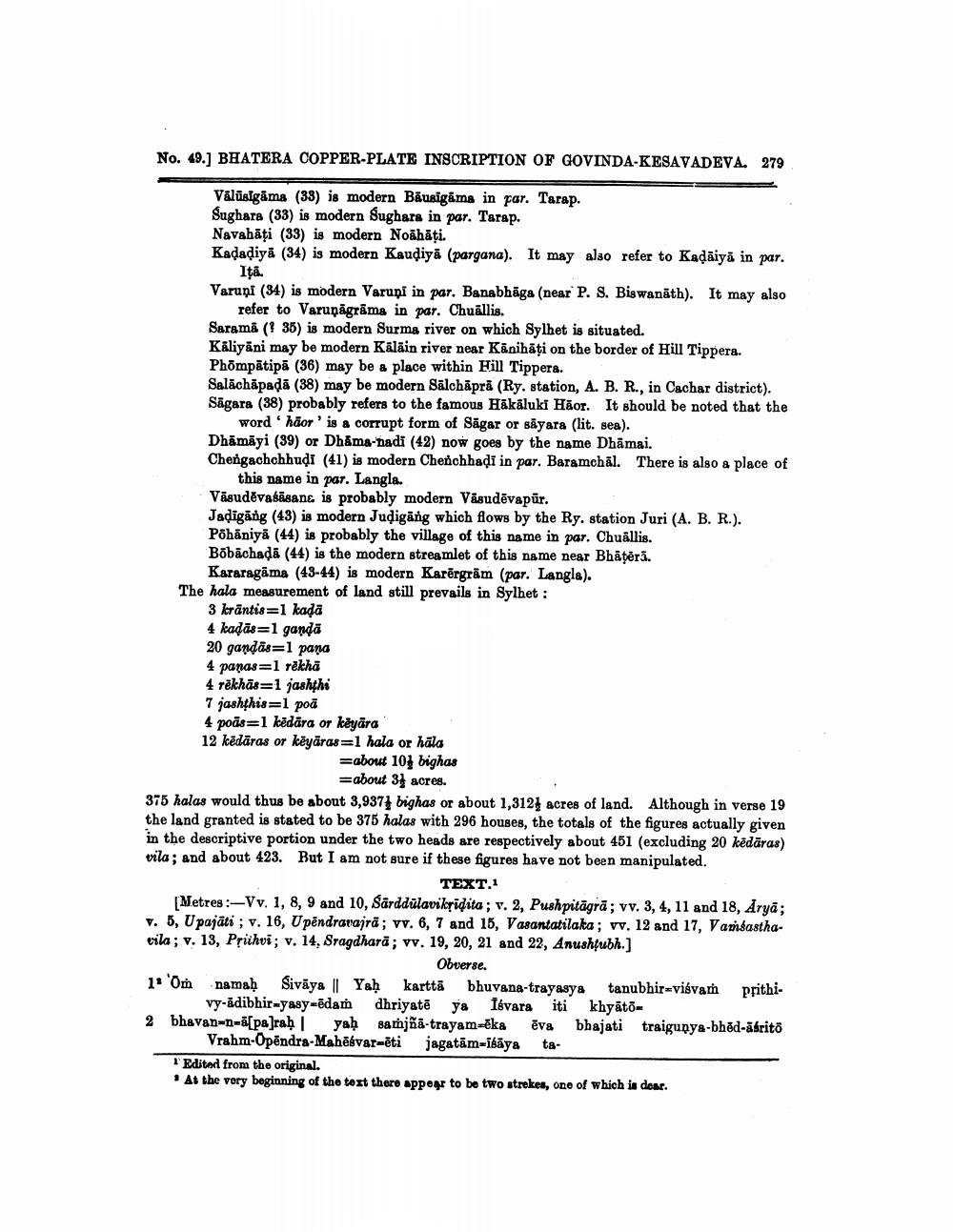________________
No. 49.] BHATERA COPPER-PLATE INSCRIPTION OF GOVINDA-KESAVADEVA. 279
Välüsīgāma (33) is modern Bäusīgāma in par. Tarap.
Sughara (33) is modern Sughara in par. Tarap.
Navahați (33) is modern Noahāți.
Kadaḍiya (34) is modern Kaudiya (pargana). It may also refer to Kaḍaiya in par.
Ita.
Varuņi (34) is modern Varupi in par. Banabhaga (near P. S. Biswanath). It may also refer to Varunagrama in par. Chuallis.
Sarama (35) is modern Surma river on which Sylhet is situated.
Kaliyani may be modern Käläin river near Kanihați on the border of Hill Tippera. Phōmpātipā (36) may be a place within Hill Tippers.
Salachapada (38) may be modern Salchapra (Ry. station, A. B. R., in Cachar district). Sagara (38) probably refers to the famous Hākāluki Häor. It should be noted that the word hãor' is a corrupt form of Sagar or sayara (lit. sea). Dhamayi (39) or Dhama-nadi (42) now goes by the name Dhamai. Chengachchhudi (41) is modern Cheñchhadi in par. Baramchal. There is also a place of
this name in par. Langla.
Vasudevasasane is probably modern Vasudevapur.
Jadigang (43) is modern Juḍigäng which flows by the Ry. station Juri (A. B. R.). Põhāniya (44) is probably the village of this name in par. Chuallis.
Bōbachaḍā (44) is the modern streamlet of this name near Bhāṭērā. Kararagama (43-44) is modern Karergram (par. Langla).
The hala measurement of land still prevails in Sylhet :
3 krāntis=1 kaḍā
4 kaḍās=1 ganda 20 gandas=1 pana
4 panas=1 rēkhā
4 rekhas 1 jashthi
7 jashthis=1 poā
4 poās=1 kēdāra or keyāra
12 kēdāras or keyäras 1 hala or häla
=about 10 bighas
=about 34 acres.
375 halas would thus be about 3,9374 bighas or about 1,312 acres of land. Although in verse 19 the land granted is stated to be 375 halas with 296 houses, the totals of the figures actually given in the descriptive portion under the two heads are respectively about 451 (excluding 20 kēdāras) vila; and about 423. But I am not sure if these figures have not been manipulated.
TEXT.1
[Metres:-Vv. 1, 8, 9 and 10, Sarddulavikridita; v. 2, Pushpitāgrā; vv. 3, 4, 11 and 18, Āryā; v. 5, Upajati; v. 16, Upendravajra; vv. 6, 7 and 15, Vasantatilaka; vv. 12 and 17, Vamsasthavila; v. 13, Prithvi; v. 14, Sragdhara; vv. 19, 20, 21 and 22, Anushṭubh.]
Obverse.
1 'Om namah Sivaya || Yaḥ kartta bhuvana-trayasya tanubhir-viśvam prithivy-dibhir yaay-dah dhriyat dhriyatē ya Iévara iti khyātō
2 bhavan-n-a[paraḥ | yaḥ samjña-trayam-ēka ēva bhajati traigunya-bhod-asritō Vrahm-Opendra-Mahēévar-eti jagatam-iśāya ta
Edited from the original.
At the very beginning of the text there appear to be two strekes, one of which is dear.




